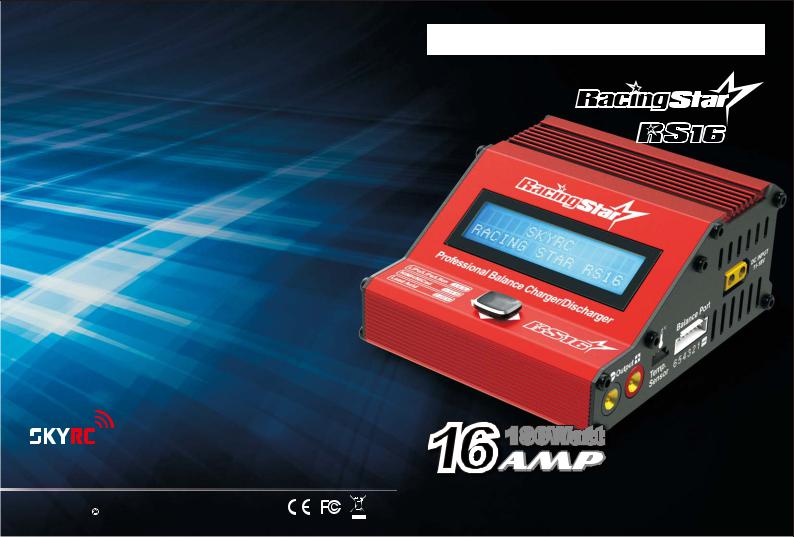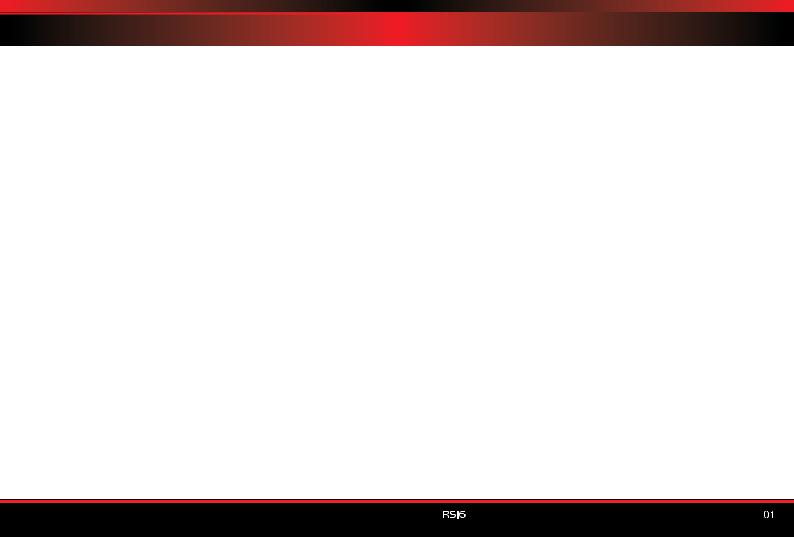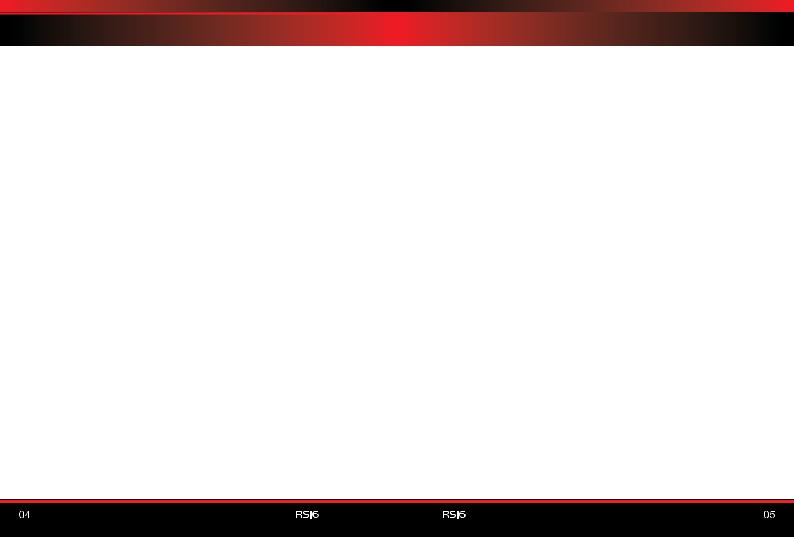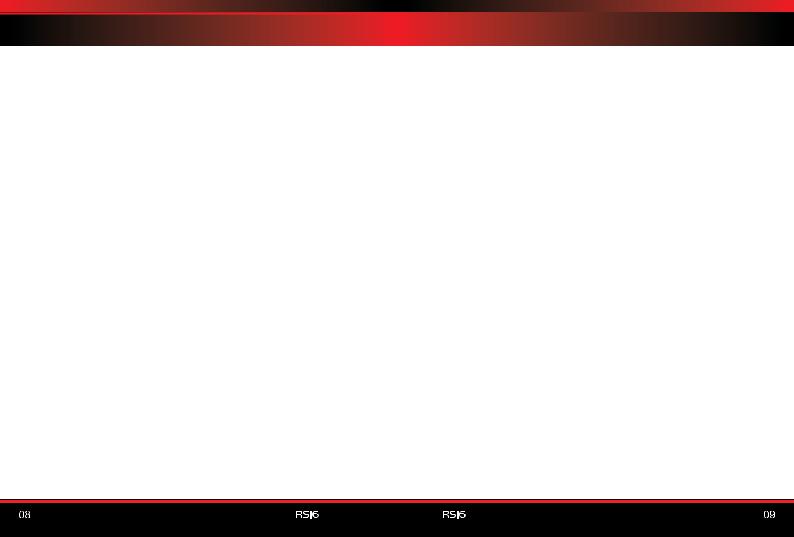SkyRC RS16 User Manual

INSTRUCTION MANUAL
Manufactured by
SKYRC TECHNOLOGY CO., LTD.
www.skyrc.com
All specifications and figures are subject to change without notice. Printed in China 2013 Version 2.0 7504-0388-02
16180 att
Professional BalanceCharger/Discharger

TABLE OF CONTENTS |
|
INTRODUCTION...................................................................................................... |
01 |
SPECIAL FEATURES............................................................................................. |
03 |
WARNING AND SAFETY NOTES......................................................................... |
06 |
CONNECTION......................................................................................................... |
10 |
LITHIUM BATTERY CONNECTION DIAGRAM .................................................... |
12 |
OPERATION............................................................................................................ |
13 |
PROGRAM FLOW CHART...................................................................................... |
14 |
LITHIUM BATTERY(LiPo/LiFe/LiIon)PROGRAM.................................................... |
16 |
Charging Lithium Battery at Balance Mode................................................................ |
16 |
Charging of Lithium Battery....................................................................................... |
17 |
‘FAST' Charging of Lithium Battery............................................................................ |
18 |
'STORAGE' Control of Lithium Battery....................................................................... |
19 |
Discharging Lithium Battery....................................................................................... |
20 |
NIMH/NICAD BATTERY PROGRAM...................................................................... |
21 |
Charging of NiMH/NiCad Battery................................................................................ |
21 |
Charging NiMH/NiCad Battery in The AUTO Charge Mode....................................... |
21 |
Discharging of NiMH/NiCad Battery............................................................................ |
22 |
Charging NiMH/NiCad Battery In Re-Peak Charge Mode.......................................... |
22 |
Charge/Discharge & Discharge/Charge Cycle of NiMH/NiCad Battery...................... |
23 |
Pb( lead-sulphuric acid) battery program................................................................ |
24 |
Charging of Pb Battery............................................................................................. |
24 |
Discharging of Pb Battery.......................................................................................... |
24 |
USING THE CHARGE CONTROL SOFTWARE “CHARGE MASTER”.................. |
25 |
BATTERY MEMORY SET...................................................................................... |
26 |
LITHIUM BATTERY METER.................................................................................. |
28 |
SYSTEM SET UP.................................................................................................... |
29 |
VARIOUS INFORMATION DURING THE PROCESS............................................. |
31 |
WARNING AND ERROR MESSAGE.................................................................... |
32 |
SPECIFICATION..................................................................................................... |
33 |
RECOMMENDED PRODUCTS............................................................................... |
34 |
LIABILITY EXCLUSION........................................................................................ |
36 |
CONFORMITY DECLARATION............................................................................. |
36 |
WARRANTY AND SERVICE................................................................................. |
37 |
INTRODUCTION
Congratulations on your choice of the SKYRC RacingStar RS16 Professional Balance Charger/Discharger from SKYRC Technology Co., Ltd. This unit is simple to use, but the operation of a sophisticated automatic charger such as RacingStar RS16 does require some knowledge on the part of the user. These operating instructions are designed to ensure that you quickly become familiar with its functions. It is therefore important that you read right through the Operating Instructions, Warning and Safety Notes before you attempt to use your new charger for the first time. We hope you have many years of pleasure and success with your new battery charger.
RacingStar RS16 represents the newest technology of chargers with its handheld super-compact portable charging system. The joystick gives the user best operational experience and also makes the charger smart and unique. There are two DC inputs, one is located in the right side of the charger and the other is located in the bottom for docking into the eFule 230W/13.8V Switch DC Power Supply.
RacingStar RS16 is a high-performance, micro processor control charge/discharge station with battery management suitable for all current battery types. With integral equalizer for six-cell LithiumPolymer (LiPo), Lithium-Ferrum (LiFe) and Lithium-Ion (LiIon) batteries; maximum 16A charge current; maximum 180W charge power.
The fan cooling system is so smart and efficient. The fan is ON/OFF automatically according due to the internal temperature.
Please BE SURE to read these INSTRUCTIONS, WARNING and SAFETY NOTES before you use the charger for the first time.
It can be dangerous to mis-handle batteries and battery chargers, as there is always a risk of batteries catching fire and exploding.
Please read this entire operating manual completely and attentively before using this product, as it covers a wide range of information on operating and safety. Or please do use this product in company with a specialist!

INTRODUCTION
LCD Screen
Joystick
Smart 
Cooling Fan
Micro USB Port for PC Control & Firmware Upgrade
DC Input Socket
(XT60 Type)
11-18V DC
Balance Socket
Port Pitch=2.54mm
Temp. Sensor
Battery Socket
 DC Input Socket
DC Input Socket
11-18V DC
SPECIAL FEATURES
Compact and Unique Design
The size of RacingStar RS16 is 92*111.4*50mm which is super-compact portable charging system. The joystick gives the user best operational experience and also makes the charger smart and unique.
Two DC inputs
There are two DC inputs, one is located in the right side of the charger and the other is located in the bottom for docking into the eFule 230W 13.8V Switch DC Power Supply(Part No. SK-200017).
Optimized Operating Software
RacingStar RS16 Charger features the so-called AUTO function that set the feeding current during the process of charging or discharging. Especially for lithium batteries, it can prevent the overcharging which may lead to an explosion due to the user's fault. It can disconnect the circuit automatically and alarm once detecting any malfunction. All the programs of this product were controlled through two way linkage and communication, to achieve the maximum safety and minimize the trouble. All the settings can be configured by users!
Internal Independent Lithium Battery Balancer
RacingStar RS16 Charger employs an individual-cell-voltage balancer. It isn't necessary to connect an external balancer for balance charging.
Balancing Individual Cells Battery Discharging
During the process of discharging, RacingStar RS16 Charger can monitor and balance each cell of the battery individually. Error message will be indicated and the process will be ended automatically if the voltage of any single one cell is abnormal.
Adaptable to Various Type of Lithium Battery
RacingStar RS16 charger is adaptable to various types of lithium batteries, such as LiPo, LiIon and the new LiFe series of batteries.

SPECIAL FEATURES
Fast and Storage Mode of Lithium Battery
Purposes to charge lithium battery varies, 'fast' charge reduce the duration of charging, whereas 'store' state can control the final voltage of your battery, so as to store for a long time and protect useful time of the battery.
Cyclic Charging/Discharging
1 to 5 cyclic and continuous process of charge>discharge or discharge > charge is operable for battery refreshing and balancing to stimulate the battery's activity.
Memory Preset
The charger can store up to 5 different charge/discharge profiles for your convenience. You can keep the data pertaining to program setting of the battery of continuous charging or discharging. Users can call out these data at any time without any special program setting.
Terminal Voltage Control (TVC)
The charger allows user to set the charge/discharge end voltage.
LiPo Battery Meter
The user can check battery's total voltage, the highest voltage, the lowest voltage and each cell's voltage.
Re-Peak Mode of NiMH/NiCad Battery
In re-peak charge mode, the charger can peak charge the battery once, twice or three times in a row automatically. This is good for making certain the battery is fully charged, and for checking how well the battery receives fast charges.
Delta-peak Sensitivity for NiMH/NiCad
Delta-peak sensitivity for NiMH/NiCad battery: The automatic charge termination program based on the principle of the delta-peak voltage detection. When the battery's voltage exceeds the threshold, the process will be terminated automatically.
SPECIAL FEATURES
Automatic Charging Current Limit
You can set up the upper limit of the charging current when charging your NiMH or NiCad battery, it is useful for the NiMH battery of low impedance and capacity in the 'AUTO' charging mode.
Capacity Limit
The charging capacity is always calculated as the charging current multiplied by time. If the charging capacity exceeds the limit, the process will be terminated automatically when you set the maximum value.
Temperature Threshold*
The battery's internal chemical reaction will cause the temperature of the battery to rise. If the temperature limit is reached, the process will be terminated.
Processing Time Limit
You can also limit the maximum process time to avoid any possible defect
PC Control Software “Charge Master”
There is a micro USB port in the charger which can be used to connect it to the PC. You need optional USB cable (USB A Male to Micro B Male) which is not included in the package. The free “Charge Master” software gives you unparalleled ability to operate the charger through your computer. You can monitor pack voltage, cell voltage and other data during the charging, view charge date in realtime graphs. And you can initiate, control charging and update firmware from “Charge Master”.
When your charger is connected to computer, the “Charger Master” takes over the control of charger. You can control and operate the charger via the “Charger Master” only.

WARNING AND SAFETY NOTES
These warnings and safety notes are particularly important. Please follow the instructions for maximum safety; otherwise the charger and the battery can be damaged or at worst it can cause a fire.
 Never leave the charger unattended when it is connected to its power supply. If any malfunction is found, TERMINATE THE PROCESS AT ONCE and refer to the operation manual.
Never leave the charger unattended when it is connected to its power supply. If any malfunction is found, TERMINATE THE PROCESS AT ONCE and refer to the operation manual.
 Keep the charger well away from dust, damp, rain, heat, direct sunshine and vibration. Never drop it.
Keep the charger well away from dust, damp, rain, heat, direct sunshine and vibration. Never drop it.
 The allowable DC input voltage is 11-18V DC.
The allowable DC input voltage is 11-18V DC.
 This charger and the battery should be put on a heat-resistant, non-flammable and non-conductive surface. Never place them on a car seat, carpet or similar surface. Keep all flammable volatile materials away from the operating area.
This charger and the battery should be put on a heat-resistant, non-flammable and non-conductive surface. Never place them on a car seat, carpet or similar surface. Keep all flammable volatile materials away from the operating area.
 Make sure you know the specifications of the battery to be charged or discharged to ensure it meets the requirements of this charger. If the program is set up incorrectly, the battery and charger may be damaged. Fire or explosion can occur due to overcharging. This warranty is not valid for any damage or subsequent damage arising as a result of a misuse or failure to observe the procedures outlined in this manual.
Make sure you know the specifications of the battery to be charged or discharged to ensure it meets the requirements of this charger. If the program is set up incorrectly, the battery and charger may be damaged. Fire or explosion can occur due to overcharging. This warranty is not valid for any damage or subsequent damage arising as a result of a misuse or failure to observe the procedures outlined in this manual.
 To avoid short circuiting between the charge lead, always connect the charge cable to the charger first, then connect the battery. Reverse the sequence when disconnecting.
To avoid short circuiting between the charge lead, always connect the charge cable to the charger first, then connect the battery. Reverse the sequence when disconnecting.
 Never attempt to charge or discharge the following types of batteries:
Never attempt to charge or discharge the following types of batteries:
 A battery pack which consists of different types of cells (including different manufacturers)
A battery pack which consists of different types of cells (including different manufacturers)
 A battery that is already fully charged or just slightly discharged
A battery that is already fully charged or just slightly discharged
 Non-rechargeable batteries (pose an explosion hazard)
Non-rechargeable batteries (pose an explosion hazard)  A faulty or damaged battery
A faulty or damaged battery
WARNING AND SAFETY NOTES
 Batteries installed in a device or which are electrically linked to other components
Batteries installed in a device or which are electrically linked to other components
 Batteries that are not expressly stated by the manufacturer to be suitable for the currents the charger delivers during the charge process
Batteries that are not expressly stated by the manufacturer to be suitable for the currents the charger delivers during the charge process
 Please bear in mind the following points before commencing charging:
Please bear in mind the following points before commencing charging:
 Did you select the appropriate program suitable for the type of battery you are charging?
Did you select the appropriate program suitable for the type of battery you are charging?
 Did you set up adequate current for charging or discharging?
Did you set up adequate current for charging or discharging?
 Have you checked the battery voltage? Lithium battery packs can be wired in parallel and in series, i.e. a 2-cell pack can be 3.7V (in parallel) or 7.4V (in series).
Have you checked the battery voltage? Lithium battery packs can be wired in parallel and in series, i.e. a 2-cell pack can be 3.7V (in parallel) or 7.4V (in series).
 Have you checked that all connections are firm and secure? Make sure there are no intermittent contacts at any point in the circuit.
Have you checked that all connections are firm and secure? Make sure there are no intermittent contacts at any point in the circuit.
Standard Battery Parameters
|
LiPo |
LiIon |
LiFe |
NiCad |
MiMH |
Pb |
|
Nominal |
3.7V/cell |
3.6V/cell |
3.3V/cell |
1.2V/cell |
1.2V/cell |
2.0V/cell |
|
Voltage |
|||||||
|
|
|
|
|
|
||
Max Charge |
4.2V/cell |
4.1V/cell |
3.6V/cell |
1.5V/cell |
1.5V/cell |
2.46V/cell |
|
Voltage |
|
|
|
|
|
|
|
Storage |
3.8V/cell |
3.7V/cell |
3.3V/cell |
n/a |
n/a |
n/a |
|
Voltage |
|||||||
|
|
|
|
|
|
||
Allowable |
1C |
1C |
4C |
1C-2C |
1C-2C |
0.4C |
|
Fast Charge |
|||||||
|
|
|
|
|
|
||
Min. Discharge |
3.0-3.3V/cell |
2.9-3.2V/cell |
2.6-2.9V/cell |
0.1-1.1V/cell |
0.1-1.1V/cell |
1.8V/cell |
|
Voltage |
|
|
|
|
|
|
Be very careful to choose the correct voltage for different types of battery otherwise you may cause damage to the batteries. Incorrect settings could cause the cells to fire or explode.
 A battery fitted with an integral charge circuit or a protection circuit
A battery fitted with an integral charge circuit or a protection circuit

WARNING AND SAFETY NOTES
 Charging
Charging
During charge process, a specific quantity of electrical energy is fed into the battery. The charge quantity is calculated by multiplying charge current by charge time. The maximum permissible charge current varies depending on the battery type or its performance, and can be found in the information by the battery manufacturer. Only batteries that are expressly stated to be capable of quickcharge are allowed to be charged at rates higher than the standard charge current.
Connect the battery to the terminal of the charger: red is positive and black is negative. Due to the difference between resistance of cable and connector, the charger can not detect resistance of the battery pack, the essential requirement for the charger to work properly is that the charge lead should be of adequate conductor cross-section, and high quality connectors which are normally goldplated should be fitted to both ends.
Always refer to the manual by the battery manufacturer pertaining to charging methods. Operate according to their recommended charging current and charging time. lithium batteries, in particular, should be charged strictly according to the manufacturer’s instruction.
Close attention should be paid to the connection of lithium batteries.
Do not attempt to disassemble the battery pack arbitrarily.
Please get highlighted that lithium battery packs can be wired in parallel and in series. In the parallel connection, the battery's capacity is calculated by multiplying single the battery's capacity by the number of cells, bearing in mind that total voltage stays the same. If the voltage is imbalanced, it may cause a fire or explosion. Lithium batteries are recommended to charge in series.
WARNING AND SAFETY NOTES
 Discharging
Discharging
The main purpose of discharging is to clean the residual capacity of the battery, or to reduce the battery' voltage to a defined level.
The same attention should be paid to the discharging process as the charging process. The final discharge voltage should be set up correctly to avoid deep discharging. Lithium batteries cannot be discharged to lower than the minimum voltage, or it will cause a rapid loss of capacity or a total failure. Generally, lithium batteries don't need to be discharged. Please pay attention to the minimum voltage of lithium batteries to protect them.
Some rechargeable batteries have a memory effect. If they are partly used and recharged before the whole charge is accomplished, they remember this and will only use that part of their capacity next time. This is a 'memory effect' It is said that
NiMH and NiCad batteries are suffering from memory effect. NiCad has more ‘memory effect’ than NiMH.
Lithium batteries are recommended to be discharged partially rather than fully. Frequent full discharging should be avoided if possible. Instead, charge the battery more often or use a battery of larger capacity. Full capacity cannot be reached until it has been subjected to 10 or more charge cycles. The cyclic process of charge and discharge will optimize the capacity of battery pack.
